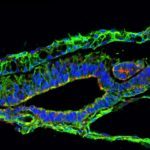Lien vers Pubmed [PMID] – 19445915
Dev. Biol. 2009 Sep;333(2):229-37
In amniotes, the dermomyotome is the source of all skeletal muscles of the trunk and the limbs. Trunk skeletal muscles form in two sequential stages: in the first stage, cells located at the four borders of the epithelial dermomyotome delaminate to generate the primary myotome, composed of post-mitotic, mononucleated myocytes. The epithelio-mesenchymal transition (EMT) of the central dermomyotome initiates the second stage of muscle formation, characterised by a massive entry of mitotic muscle progenitors from the central region of the dermomyotome into the primary myotome. The signals that regulate the timing of the dermomyotome EMT are unknown. Here, we propose that this process is regulated by an FGF signal emanating from the primary myotome, a known source of FGF. The over-expression of FGF results in a precocious EMT of the dermomyotome, while on the contrary, the inhibition of FGF signalling by the electoporation of a dominant-negative form of FGFR4 delays this process. Within the dermomyotome, FGF signalling triggers a MAPK/ERK pathway that leads to the activation of the transcription factor Snail1, a known regulator of EMT in a number of cellular contexts. The activation or the inhibition of the MAPK/ERK pathway and of Snail1 mimics that of FGF signalling and leads to an early or delayed EMT of the dermomyotome, respectively. Altogether, our results indicate that in amniotes, the primary myotome is an organizing center that regulates the timely entry of embryonic muscle progenitors within the muscle masses, thus initiating the growth phase of the trunk skeletal muscles.

